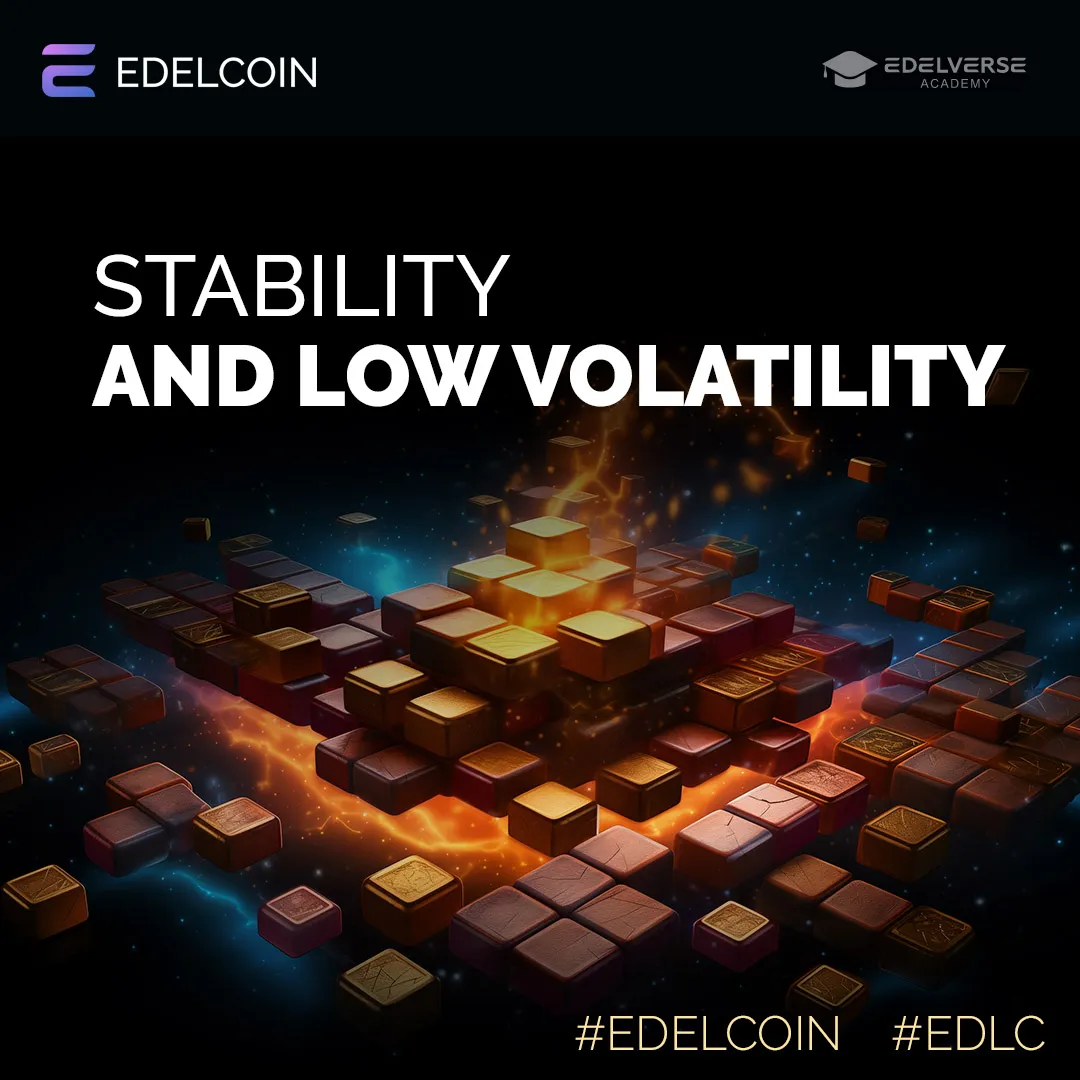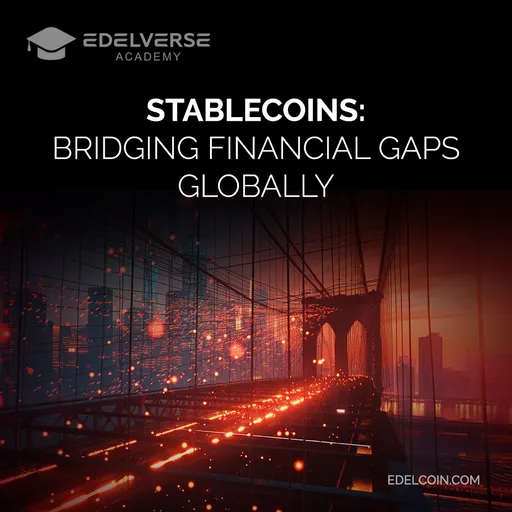
Commodity-Backed Stablecoins
A Deep Dive
Introduction
In the dynamic and often volatile world of cryptocurrencies, stablecoins have emerged as a crucial solution to the issue of price stability. Unlike traditional cryptocurrencies like Bitcoin and Ethereum, known for their significant price fluctuations, stablecoins aim to maintain a stable value. They achieve this by pegging their value to more stable assets such as fiat currencies, commodities, or a basket of assets. This article explores the concept of stability and low volatility in crypto, compares different stablecoins, and discusses their advantages and shortcomings. Finally, we will see how Edelcoin addresses the issue of volatility.
Understanding Stablecoins
Stablecoins are a type of cryptocurrency designed to minimize price volatility by being pegged to a stable asset. They can be broadly classified into three categories: fiat-collateralized, crypto-collateralized, algorithmic stablecoins, and commodity-backed stablecoins.
Fiat-Collateralized Stablecoins
Fiat-collateralized stablecoins are backed by fiat currencies such as the US dollar, euro, or yen. The issuer holds reserves of the fiat currency equivalent to the value of the stablecoins issued.
Examples:
- Tether (USDT): The most widely used stablecoin, Tether is pegged to the US dollar. Each USDT is backed by one US dollar held in reserve.
- USD Coin (USDC): Another popular stablecoin, USDC is also pegged to the US dollar and is managed by the Centre consortium, which includes Circle and Coinbase.
Advantages:
- Stability: These stablecoins offer high stability due to their direct pegging to fiat currencies.
- Trust: Users can trust that each stablecoin is backed by real fiat currency reserves.
Shortcomings:
- Centralization: Fiat-collateralized stablecoins are often criticized for their centralized nature, as they require a trusted third party to hold the reserves.
- Regulatory Risks: They are subject to regulatory scrutiny and may face legal challenges.
Crypto-Collateralized Stablecoins
Crypto-collateralized stablecoins are backed by other cryptocurrencies. These stablecoins are often over-collateralized to account for the volatility of the underlying cryptocurrencies.
Examples:
- Dai (DAI): Managed by the MakerDAO protocol, Dai is pegged to the US dollar but is backed by various cryptocurrencies deposited as collateral in smart contracts.
Advantages:
- Decentralization: These stablecoins are more decentralized than fiat-collateralized stablecoins, as they do not rely on a single entity to hold the collateral.
- Transparency: The collateral is stored on the blockchain, ensuring transparency and auditability.
Shortcomings:
- Complexity: The mechanisms to maintain the peg can be complex and require active management.
- Volatility: The value of the collateral can still be volatile, posing risks to the stability of the stablecoin.
Algorithmic Stablecoins
Algorithmic stablecoins use algorithms and smart contracts to maintain their value. They are not backed by any collateral but instead rely on supply and demand mechanisms to stabilize their price.
Examples:
- TerraUSD (UST): TerraUSD was designed to maintain its peg to the US dollar through an algorithmic mechanism involving the burning and minting of its sister coin, LUNA.
Advantages:
- Scalability: These stablecoins can theoretically scale without the need for collateral.
- Decentralization: They are typically more decentralized, as they do not require collateral to be held by a central entity.
Shortcomings:
- Instability: Algorithmic stablecoins can be highly unstable, as seen with TerraUSD's collapse in 2022 when it lost its peg to the US dollar.
- Complexity: The algorithms can be complex and difficult for users to understand.
Commodity-Backed Stablecoins
Commodity-backed stablecoins are pegged to the value of physical assets such as gold, silver, or other commodities. This category includes Edelcoin, which uses a unique approach by backing its value with a combination of precious and base metals.
Examples:
- Paxos Gold (PAXG): Each token is backed by one fine troy ounce of a London Good Delivery gold bar stored in Brinks vaults.
- Edelcoin: Backed by a diversified reserve of precious and base metals, providing stability through tangible asset backing.
Advantages:
- Tangible Value: These stablecoins are backed by physical assets with intrinsic value.
- Stability: The backing by commodities helps ensure lower volatility compared to other stablecoins.
Shortcomings:
- Storage and Security Costs: Commodities' physical storage and security can be costly.
- Limited Liquidity: The liquidity of commodity-backed stablecoins can be limited by the liquidity of the underlying assets.
Comparing Stablecoins
Stability and Trust
Fiat-collateralized stablecoins like USDT and USDC offer the highest stability and trust, thanks to their direct pegging to fiat currencies. However, their centralized nature and regulatory risks are significant drawbacks.
Crypto-collateralized stablecoins like Dai provide a more decentralized and transparent alternative. However, their stability can be affected by the volatility of the underlying cryptocurrencies.
While algorithmic stablecoins offer potential scalability and decentralization, they have yet to prove their long-term stability, as evidenced by past failures like TerraUSD.
Commodity-backed stablecoins like Edelcoin offer a stable and tangible asset-backed alternative. The backing by precious and base metals ensures stability and lower volatility, making them a reliable option in the stablecoin market.
Use Cases and Adoption
Fiat-collateralized stablecoins are widely used for trading and payments due to their stability and trust. They are also favored by institutional investors who require a stable store of value.
Crypto-collateralized stablecoins are popular in the DeFi (decentralized finance) ecosystem, where decentralization and transparency are highly valued.
Algorithmic stablecoins have seen limited adoption due to their inherent risks and instability.
Commodity-backed stablecoins are gaining traction as a stable and reliable option, especially when tangible asset backing is preferred.
Regulatory Landscape
Fiat-collateralized stablecoins face the most regulatory scrutiny, directly tied to fiat currencies and financial institutions.
While crypto-collateralized and algorithmic stablecoins currently face less regulatory pressure, they could face increased scrutiny as their use grows.
Commodity-backed stablecoins, like Edelcoin, navigate a unique regulatory landscape, balancing the physical nature of their backing assets with the digital nature of their token.
How Edelcoin Ensures Stability and Low Volatility
Edelcoin adopts a unique approach to stability by backing its value with a combination of precious and base metals. This strategy leverages the inherent stability of these metals to ensure the coin’s value remains stable and less susceptible to market volatility.
Backing by Precious and Base Metals
Precious metals like gold and silver are known for their stability and have long been considered safe-haven assets. Base metals like copper and nickel, while not as valuable, provide additional stability through their steady industrial demand.
Diversified Asset Backing
Edelcoin ensures a diversified and resilient asset base by combining precious and base metals. This diversification mitigates the risks of relying on a single asset class, providing a more stable and predictable value.
Reduced Speculative Influence
Edelcoin’s backing by tangible assets reduces the influence of speculative activities, ensuring lower volatility. This stability makes Edelcoin a reliable medium of exchange and a dependable store of value.
Transparency and Trust
Edelcoin ensures transparency by regularly auditing its metal reserves and providing users with verifiable proof of its asset backing. This transparency builds trust and confidence in Edelcoin's stability.
Conclusion
Stablecoins have become a vital component of the cryptocurrency ecosystem, offering a stable alternative to volatile traditional cryptocurrencies. While fiat-collateralized stablecoins provide the highest level of stability and trust, their centralized nature and regulatory risks are significant drawbacks. Crypto-collateralized stablecoins offer a more decentralized alternative but face challenges related to the volatility of their collateral. Algorithmic stablecoins, while promising in theory, have yet to demonstrate long-term stability.
Edelcoin addresses the issue of volatility by backing its value with a combination of precious and base metals. This unique approach ensures a stable and low-volatility cryptocurrency, providing users with a reliable medium of exchange and a dependable store of value. By leveraging the stability of tangible assets, Edelcoin sets a new standard for stability and low volatility in the crypto space.

Test Your Knowledge
- Which of the following stablecoins is an example of a fiat-collateralized stablecoin?
a. Tether (USDT)
b. Dai (DAI)
c. Paxos Gold (PAXG)
2. What is a primary advantage of commodity-backed stablecoins like Edelcoin?
a. Decentralization
b. Tangible Value
c. Scalability
3. What is a significant shortcoming of crypto-collateralized stablecoins?
a. Regulatory Risks
b. Storage and Security Costs
c. Volatility of Collateral
Correct answers: 1a, 2b, 3c.
Contents





